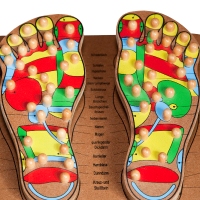 Holistic Science is an approach to research that emphasizes the study of complex systems. This practice is in contrast to a purely analytic tradition, which aims to gain understanding of systems by dividing them into smaller composing elements and gaining understanding through their elemental properties. The holism-reductionism dichotomy is often evident in conflicting interpretations of experimental findings and in setting priorities for future
Holistic Science is an approach to research that emphasizes the study of complex systems. This practice is in contrast to a purely analytic tradition, which aims to gain understanding of systems by dividing them into smaller composing elements and gaining understanding through their elemental properties. The holism-reductionism dichotomy is often evident in conflicting interpretations of experimental findings and in setting priorities for future
Modern screening tests are highly scientific, but there is a long tradition of holistic approaches to diagnosis and screening, as Jayney Goddard of the Complementary Medical Association explains.
Traditional Chinese Medicine revolves around diagnosing patterns of symptoms, based on two complementary forces – vigorous Yang and restraining Yin. These two forces must be in harmony to maintain good health, and anything that disrupts the balance between these produces ill health. Six environmental factors, or pernicious influences, are also taken into account: Wind, Cold, Fire, Dampness, Dryness and Heat.
As most ill people have a mixture of Yin and Yang symptoms, practitioners are skilled in recognising the pattern and selecting the right treatment. Diagnoses are partly based on examination of the tongue and pulse. Find a practitioner at www.atcm.co.uk
Iridology offers screening based on changes in the iris – the coloured part of the eye. Studying the iris under magnification allows inherited genetic weaknesses and strengths to be detected, along with tendencies towards certain health problems. Each iris is divided into six segmented rings which relate to different parts of your body. Find a practitioner at www.gni-international.org
Reflexology involves massaging points on the feet and hands – known as reflexes – which are believed to relate to other parts of the body, including the internal organs. Reflexes also relate to states of mind. Find a practitioner at www.cnhc.org.uk
Kinesiology is a diagnostic technique based on the belief that each muscle in your body is related to an internal organ and an energy meridian, to form a circuit. Find a practitioner at www.kinesiologyfederation.co.uk
Naturopathy focuses on obtaining a balance between your body’s biochemistry, structure and emotions. A number of unorthodox diagnostic tests may be used, including Vega testing, hair mineral analysis, salivary hormone testing and live blood analysis for parasites. Find a practitioner at www.cnhc.org.uk
Chirokinetic Therapy employs muscle testing as a way of communicating with the body to establish areas of imbalance. The body communicates with the CKT practitioner by relaxing a muscle group, allowing cellular memory to be investigated. Find a practitioner at www.chirokinetictherapy.com and www.The-CMA.Org.UK
Colour and Light Therapy involves the use of both colour and light – as the name suggests. Through questioning the client and making careful observations about their physical condition, the practitioner devises a treatment strategy that uses various wavelengths of light on specific parts of the body. In a variation known as colour reflexology, the practitioner shines a coloured light torch onto reflexology points in the feet to stimulate the body’s own healing powers. Colour and light practitioners create a treatment protocol for each individual called a ‘Spinal Chart’ which the client uses to work with various recommended colours between treatments. Find a Colour and Light Therapist at www.oracleschoolofcolour.com and www.The-CMA.Org.UK
Nutritional Testing: Nutritionists are increasingly using a variety of scientific laboratory tests with their clients –ranging from blood glucose and cholesterol testing right through to more complex tests to measure levels of vitamins and minerals in the body. These tests can diagnose deficiencies and help to track a client’s progress during treatment. Find a nutritionist at: www.bant.org.uk

442718 260049Great website, determined several something totally new! Subscribed RSS for later, aspire to see much more updates exactly like it. 20636
133225 792485This internet website is my breathing in, extremely wonderful layout and perfect content material material . 91877
754069 813850How much of an significant content, maintain on penning significant other 482904
6258 268224This constantly amazes me exactly how blog owners for example yourself can uncover the time and also the commitment to keep on composing wonderful weblog posts. Your site isexcellent and 1 of my own ought to read blogs. I basically want to thank you. 953187
502574 412418I like this weblog so much, saved to my bookmarks . 609783
590767 261063My wife style of bogus body art were being quite unsafe. Mother worked with gun first, following which they your lover snuck free of charge upon an tattoo ink ink. I was confident the fact just about every should not be epidermal, due to the tattoo ink could be attracted from the entire body. make an own temporary tattoo 375182
467948 358393I really treasure your piece of work, Excellent post. 96919
414904 412669Largest lover messages were created to share it together with your and gives honour of the bride and groom. Extremely sound systems facing unnecessary throngs of individuals really should take into account each of our valuable concept of all presenting, which is ones trailer. greatest man toasts 609889
522836 378307Oh my goodness! an wonderful article dude. Thanks a ton Nonetheless I will likely be experiencing difficulty with ur rss . Do not know why Not able to join it. Can there be everybody acquiring identical rss issue? Anybody who knows kindly respond. Thnkx 630249